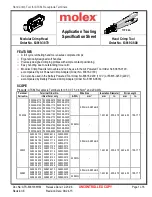
Jabiru Aircraft
Pilot Operating Handbook
Model J170-D
JP-FM-13
Revision:
0
1
2
3
4
28 Feb 2020
Page 4-41
4.6
AMPLIFIED PROCEDURES
This section is provided to supply the pilot with additional information concerning normal
procedures in general. Elaboration of the procedures specified in the NORMAL PROCEDURES
CHECK LISTS as well as the inclusion of some more generalised procedures that can be better
covered by a general descriptive procedure rather than a formal check list are included in this
section. This will give the pilot a more complete understanding of these procedures.
4.6.1
Preflight Inspection
The Preflight inspection as covered by the PREFLIGHT INSPECTION CHECKLIST is
recommended prior to the first flight of the day. Inspection procedures for subsequent flights can
be abbreviated provided essential items such as fuel and oil quantities, security of fuel and oil filler
caps are satisfactory. After refuelling fuel samples must be taken from all drain points, three in
total, one in each of the two wing fuel tanks and one under the fuselage.
Aircraft operated from rough strips, especially at high altitudes, are subject to abnormal
undercarriage abuse. Frequent checks of all undercarriage components, tyres and brakes is
warranted in these situations.
4.6.2
Electric Fuel Gauges (where equipped):
The fuel gauges used in the J170-D use a sender unit which has a built-in analogue needle
indicator for fuel level. These senders are located in the wing roots and are visible to the crew.
these units may be used to confirm the fuel level being displayed by the indicators fitted to the
instrument panel. Note that due to the shape of the wing tanks, the gauges will read full from when
the tank is full until it’s level has dropped below around 50 litres. This must be taken into account
by manually checking fuel quantity (dipping the tanks) before a long flight.
4.6.3
Starting Engine
The Jabiru 2200 engine is fitted with a dual electronic ignition system. The engine will not start
below 300 RPM, which precludes the option of hand swinging or "propping" an engine when there
is insufficient charge available in the aircraft battery for a normal start. Starting using an external
power source involves removing the upper engine cowl, attaching jumper leads to the battery
terminals
or using jump start connector (if fitted). Then proceed
with the normal start sequence.
It
is recommended that the battery is charged before flight is undertaken
.
WARNING
If cowl was removed for engine starting, shut down before re-fitting the engine cowl.
After starting, oil pressure should start to rise within 10 seconds. If it does not rise within this time
stop the engine and investigate the cause.
WARNING
Flight should not be undertaken with a faulty battery. It could cause failure of the
electrical system.
The charging system in the Jabiru is not designed to be flown with a flat or faulty battery. If
external power is required to start the engine the batteries condition should be verified.
















































